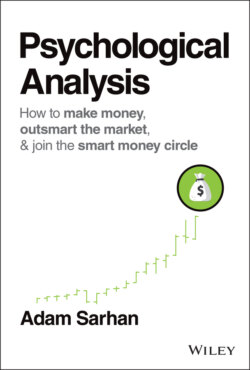Читать книгу Psychological Analysis - Adam Sarhan - Страница 43
Orders
ОглавлениеThere are many ways you can enter and exit a position. Some of the basic ways are listed here, but I strongly recommend that you ask your broker what their terminology is for placing orders and ask them to give you examples for each order before placing any trades.
Market Order: A market order means that you want to buy or sell immediately at the best available price. A note of caution: If the market is trading in large ranges, you might have a bad fill, meaning the transaction occurred at a different price than you had hoped for. Perhaps a buyer wanted to fill an order at $50 per share, but by the time the order was processed, the stock was trading at $51. The difference between where you want to get filled and where you are actually filled is called slippage. A fill refers to where your order is executed (or where it was “filled”).
Limit Order: A limit order is used to buy or sell an asset at a specific price or better. Here's how it works in layman's terms: if the market price is $20 and you place a limit order to buy at $19, then your order will be executed at $19 or lower. Meaning, if the stock goes up and never touches $19, that order will not be filled. By definition, a buy limit order can only be filled at the limit price or lower. On the other hand, if you place a sell limit order, it can only be executed at the limit price or higher; for example, if you want to sell a stock at $55 and the stock is falling and never hits $55, your sell limit order will not be filled.
Stop Order: A stop order is very useful when used properly. A buy stop will be placed above the market price, and the order will only be triggered when the stock moves above that price. Conversely, a sell stop is an order that is placed below a specified price and will only trigger if the stock reaches your stop price. It is important to note that when the stop price is reached, a stop (buy stop and or a sell stop) order becomes a market order and is filled at the best available price, so there is no guarantee that you get filled at your stop price (meaning there could be some slippage). A buy stop order is set above the market and is used to enter a long or exit a short position if the stock rallies to your stop price. Conversely, a sell stop is placed below the market and is used to enter a short position or exit your long position if the market declines. We'll talk a lot about sell stops in this book, so this term is essential to remember.
Trailing Stops: Trailing stop orders are orders that move higher or lower based on the market action. In most cases, they are used as “trailing stop‐loss orders.” For example, the market may be moving higher and you set a trailing stop to exit your position if certain criteria that you define are met. This way, the stop moves higher as the market rallies (or moves lower as the market declines).
Conditional Orders: Conditional orders are advanced orders that allow you to set instructions for your broker to submit or cancel a trade if specific criteria are met. In most cases, conditional orders are considered the most basic form of automating a trade.
Day versus Good Till Canceled (GTC) Orders: When you enter a new order, you have the option of setting it so it expires at the end of the day or GTC. Most brokers set GTC orders to expire between 30 to 90 days—or until the trader manually cancels the order. Hence, the name GTC.
